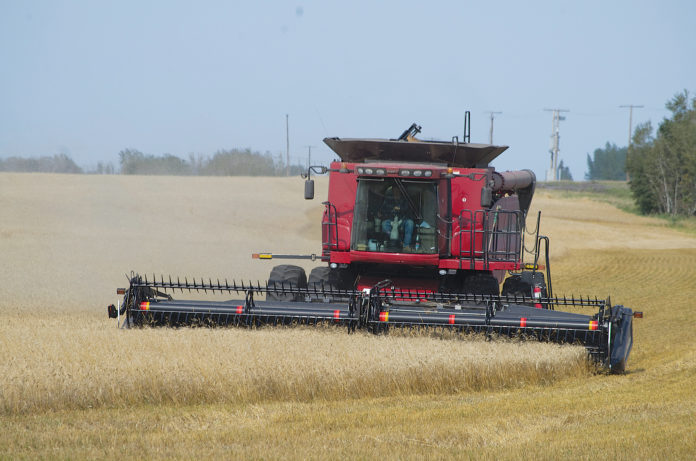Ministry of Agriculture, Submitted
Scattered showers across the province paused harvest for a short time, but producers welcomed the moisture. Saskatchewan crops are nine per cent harvested this week, ahead of the five-year average of eight per cent and the 10-year average of five per cent.
The southwest is leading the province in harvest progress, with 20 per cent of this year’s crop harvested for the year. Producers in the northwest were delayed this week due to rain showers and have harvested only one per cent of this year’s crop. Producers have made progress harvesting all crops this week, excluding flax. Fall cereals are still the most harvested crop this week, with 61 per cent of fall rye and 56 per cent of winter wheat taken off for the year. Field peas and lentils are the most harvested spring seeded crops; 36 per cent of both field peas and lentils have been harvested provincially. Oilseeds, in general, have been harvested the least so far.
All crop districts received some moisture with the showers that moved across the province this week. The most significant moisture received was 67 mm in Esterhazy, followed closely by 63 mm in Lipton. An increase in soil moisture was recorded this week. In cropland, 26 per cent of topsoil has adequate moisture, 45 per cent is short and 29 per cent is very short. Twenty-one per cent of hay and pasture land has adequate topsoil moisture, 45 per cent is short and 34 per cent is very short.
Crop reporters were asked to report on water supply and quality this week. Provincially, moderate water supply shortages are occurring for livestock producers, with many anticipating more significant shortages soon while some are already reporting severe water shortages. Producers can visit their local regional office to have the quality of their livestock water sources tested.
Crop damage this past week was due to drought, wind damage, gophers, grasshoppers and flea beetles. Producers are busy combining and desiccating crops this week, while others are marketing cattle and hauling water for livestock.
Harvest is a busy time for producers. The public is reminded to give machinery extra space and time when travelling on roadways. The risk of fire this harvest is exacerbated by the dry conditions seen throughout the growing season and producers are encouraged to have fire mitigation resources at the ready. Dry conditions can be stressful for producers, and they are reminded to take safety precautions in all the work they do. The Farm Stress Line is available to provide support to producers toll free at 1-800-667-4442. Additional resources related to dry conditions are available on this webpage or by contacting their regional office.
Northeastern Saskatchewan
Producers in the northeast have been busy combining this week and are now two per cent completed harvest. This is just behind the five-year average of three per cent.
Producers completed harvest of fall cereals in the region and are moving onto spring seeded crops. Just under five per cent of barley has been harvested for the year. Spring seeded pulses are also being combined, with four per cent of lentils in the bin for the year and an additional 15 per cent used as a feed source. Fourteen per cent of peas are harvested for the year. Few oilseeds have been harvested in the region.
Pockets of moisture have moved through the region this week, leaving some areas with significant moisture. Kinistino recorded the most rainfall, with 42 mm being received. Other areas of the region received only trace amounts. Topsoil moisture was slightly replenished this week, one per cent of cropland has surplus topsoil moisture, 49 per cent has adequate moisture, 46 per cent is short and four per cent is very short. Hay and pasture land follows a similar pattern, with one per cent having surplus moisture, 44 per cent is adequate for moisture, 53 per cent is short and two per cent is very short. Although the rain helped with topsoil moisture, livestock producers are experiencing moderate water supply shortages and water quality is a concern.
Crop damage this past week is due to localized flooding and some hail. Producers are busy evaluating grain moisture levels, marketing livestock and harvesting crops.
Northwestern Saskatchewan
Producers in the northwest have started getting their combines into the fields this week. Approximately one per cent of the region is harvested. This is behind the five-year average of two per cent. Rain this past week has delayed harvest.
Producers in the region are primarily harvesting pulse crops this week. Lentils are the most harvested, with 28 per cent of this year’s crop in the bin. Field peas are also being taken off, with five per cent of the crop harvested. Few oilseeds and cereals have been harvested so far.
Scattered showers moved through the region this past week, providing significant moisture for some parts of the northwest. Duck Lake recorded the most rain, with 50 mm being reported. Other parts of the region only received trace amounts of rain. Topsoil moisture increased this week. Thirty-eight per cent of cropland has adequate topsoil moisture, 46 per cent is short and 16 per cent is very short. Forty per cent of hay and pasture land has adequate topsoil moisture, 34 per cent is short and 26 per cent is very short. Livestock producers are experiencing water supply shortages, with some anticipating they’ll encounter challenges in the months. Water quality is a concern for livestock producers.
Crop damage this past week is due to drought stress, flea beetles and grasshoppers. Producers are busy swathing, desiccating and harvesting crops. Livestock producers are working and marketing cattle.


